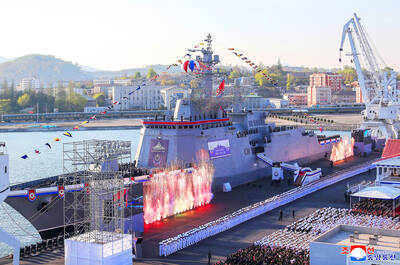Buttons were an invention waiting to happen. Since the dawn of time when early man draped himself in animal pelts, he has needed a way of opening and closing his clothing.
An exhibition in Paris pays tribute to this often unconsidered but essential item, showcasing about 1,500 of the rarest and most beautiful buttons amassed by French collector Loic Allio over 20 years.
Nobody knows when the first button emerged, but it was probably a piece of bone or shell, attached by string. Prehistoric buttons have been found in Egypt, Iran and Greece.
The earliest examples in the show include Chinese buttons in agate from the Han tombs dating back to the Dian kingdom (206BC to 220AD). Buttons tend to survive long after the fabric they were sewn onto has rotted away.
The golden age of the button was in 18th-century France, when they adorned redingotes and waistcoats. At the time of the French Revolution 1,000 workers were employed in the button industry.
The best buttons were exquisite miniature works of art, such as black and white or hand-tinted engravings, covered in glass and encased in metal circles.
Gift sets of fine buttons made by goldsmiths were considered suitable wedding presents.
Some were commemorative. The show has examples marking events as diverse as the first hot air balloon flight by the Mongolfier brothers in 1780, George Washington’s investiture, the abolition of slavery and the storming of the Bastille in Wedgwood-style blue and white porcelain.
It also has a few of the 18th century’s answer to pornography: buttons with erotic drawings that “libertines” wore concealed behind their lapels or inside their collars.
By the 19th century production became more industrialized, with the use of transfers replacing handpainted porcelain, although fine materials such as horn, tortoiseshell, silver, copper and ivory were still commonplace.
Buttons also reflected the main artistic movements of the day — Art Nouveau in the 1890s and Art Deco in the 1920s, when early plastics suddenly became fashionable.
The emergence of haute couture at the end of the 19th century created a big demand for unique, one-off buttons. In its heyday between the 1930s and 1950s there were more than 80 couture fashion houses in Paris, putting out four collections a year, providing work for 15 specialist suppliers, who also made belt buckles and hat pins.
Among the big names, now forgotten, were the writer Victor Hugo’s grandson Francois Hugo, who was a friend of Jean Cocteau, Max Ernst, Jean Arp and Pablo Picasso, and Henri Hamm, whose circle included the poet Guillaume Apollinaire and artists Amadeo Modigliani and Henri Douanier Rousseau.
The exhibition is open until Aug. 14 at the Mona Bismarck Foundation on the Avenue New York.

Archeologists in Peru on Thursday said they found the 5,000-year-old remains of a noblewoman at the sacred city of Caral, revealing the important role played by women in the oldest center of civilization in the Americas. “What has been discovered corresponds to a woman who apparently had elevated status, an elite woman,” archeologist David Palomino said. The mummy was found in Aspero, a sacred site within the city of Caral that was a garbage dump for more than 30 years until becoming an archeological site in the 1990s. Palomino said the carefully preserved remains, dating to 3,000BC, contained skin, part of the

TRUMP EFFECT: The win capped one of the most dramatic turnarounds in Canadian political history after the Conservatives had led the Liberals by more than 20 points Canadian Prime Minister Mark Carney yesterday pledged to win US President Donald Trump’s trade war after winning Canada’s election and leading his Liberal Party to another term in power. Following a campaign dominated by Trump’s tariffs and annexation threats, Carney promised to chart “a new path forward” in a world “fundamentally changed” by a US that is newly hostile to free trade. “We are over the shock of the American betrayal, but we should never forget the lessons,” said Carney, who led the central banks of Canada and the UK before entering politics earlier this year. “We will win this trade war and

‘BODIES EVERYWHERE’: The incident occurred at a Filipino festival celebrating an anti-colonial leader, with the driver described as a ‘lone suspect’ known to police Canadian police arrested a man on Saturday after a car plowed into a street party in the western Canadian city of Vancouver, killing a number of people. Authorities said the incident happened shortly after 8pm in Vancouver’s Sunset on Fraser neighborhood as members of the Filipino community gathered to celebrate Lapu Lapu Day. The festival, which commemorates a Filipino anti-colonial leader from the 16th century, falls this year on the weekend before Canada’s election. A 30-year-old local man was arrested at the scene, Vancouver police wrote on X. The driver was a “lone suspect” known to police, a police spokesperson told journalists at the

North Korean leader Kim Jong-un has unveiled a new naval destroyer, claiming it as a significant advancement toward his goal of expanding the operational range and preemptive strike capabilities of his nuclear-armed military, state media said yesterday. North Korea’s state-run Korean Central News Agency (KCNA) said Kim attended the launching ceremony for the 5,000-tonne warship on Friday at the western port of Nampo. Kim framed the arms buildup as a response to perceived threats from the US and its allies in Asia, who have been expanding joint military exercises amid rising tensions over the North’s nuclear program. He added that the acquisition